Recently, it was known that the Sloth became the 16th national symbol of Costa Rica, a joy that arose after the deputies of the Third Full Commission of the Legislative Assembly unanimously approved the Law whose file is No. 22,167, which also tries to protect the habitat and ensure the conservation of the species Choloepus hoffmanni (two-toed sloth) and Bradypus variegatus (three-toed sloth) in the country’s wildlife.
This is a positive context for the nation, because when people see a sloth it can be made to identify with Costa Rica. It is worth noting that the sloth can be seen as a completely spontaneous, immense animal and good in every sense of the word.
As in Costa Rica with sloths, other countries have incredible species, considered national symbols, for example, the koala from Australia, the panda from China and even the troupial from Venezuela.
Greater protection for Sloths
The decision of the members of the legislative branch has shown a wonderful intention of the country with wildlife. In this sense, the Sloth will have greater benefits, because the law delegates to the Ministry of Environment and Energy their conservation and protection in addition to its habitat.
The experts, through the Ministry of Public Works and Transportation, will be deployed in the direction of the national route, precisely in places with the greatest impact where sloths and other species of animals must be protected to not be run over in roads.

Additionally, the Costa Rican Electricity Institute and private electricity companies must implement measures to reduce damage or injuries caused in the power lines. In this regard, the Ministry of Environment and Energy presented the second edition of the guide for the Prevention and Mitigation of Electrocution of Wild Fauna by Power Lines in Costa Rica.
The guide was updated by the Sustainable Electrification Working Group, which has expanded the Citizen Participation section, where precise information is provided on how anyone in the country can communicate with the different companies to report the electrocution of wild animals or places in the wiring of the passage of animals, problems due to the growth of vegetation touching power lines, among other risks.
It is noteworthy that the Instituto Costarricense de Turismo urges that the image of the sloth be used for advertising campaigns, locally and internationally; Other organizations of the Costa Rican Government and companies, both public and private, should develop initiatives that promote the conservation of sloths and their habitat.
What you didn’t know …
Some time ago, engineers from the United States, created a robot inspired by the Sloth of Costa Rica. This robot was designed to study climate change. In the Central American country, various companies carry out educational tours so that sloth fans can learn about the species and, in the same way, are motivated to support organizations that work to conserve them.
Like many of the world’s species, the Sloth, having a gentle nature, can be victims of exotic animal trafficking. There are other things about sloths that you may not know and that is that a family of this species of Costa Rican fauna will no longer have to cross a street located in San Rafael (Heredia), which means that they will have less chance of being run over by a vehicle. Everything is thanks to the Public Services company of Heredia (ESPH), which installed a hanging step. This airlift is part of a project to place 10 similar steps in the Heredian mountains.
And finally, experts affirm that South America gave us the two species of sloths, and also what is the guanacaste tree (Enterolobium cyclocarpum), the yigüirro (Turdus grayi), the white-tailed deer (Odocoileus virginianus) and the manatee ( Trichechus manatus).

